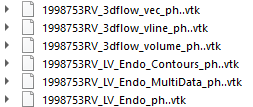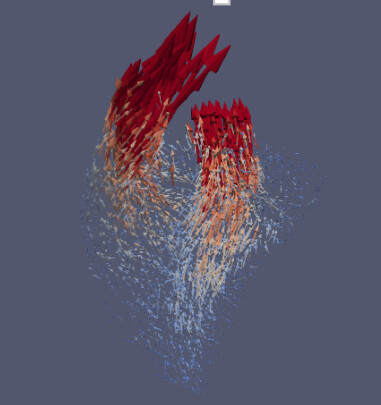Hi,
I have .vtk file of a 4DFlow of the blood within the ventricles. I have the velocity field dataset.
I also have these dataset

How can I visualize the pathline and the streamline?
Thank you
Hi,
I have .vtk file of a 4DFlow of the blood within the ventricles. I have the velocity field dataset.
I also have these dataset

How can I visualize the pathline and the streamline?
Thank you
please share your data
I have this type of data but for 30 phases.
1998753RV_3dflow_vec_ph001.vtk (535.2 KB)
1998753RV_3dflow_volume_ph001.vtk (1.4 MB)
1998753RV_3dflow_vline_ph001.vtk (804.9 KB)
I have this type of data but for 30 phases
Oh, yes thank you! These are streamlines, right?
But how can I choose the right direction of the tracer arrow?
The streamlines follow the vectors in your data.
Yes, this is how the stream tracer works, it seeds the streamlines from the line. You can choose another type of seed if you want.
Thank you very much, you save me a lot of time. Last thing, is it possible to calculate the viscous energy loss in paraview?
You will need to use the python calculator or programmable filter to do such a specific computation.
Oh ok so I can directly import the data in Python and calculate the viscous energy loss there.
Thank you very much again
Hey, do you know how can I visualize the pathline instead?
Thank you
What is a pathline ? How does it differ from a streamline ?
The streamline follow the velocity field instead the pathline follow the flow
There is only the velocity field on your data, the is no flow field.
But I can see the flow

These are glyphs representing the flow, but the flow data itself is missing from the Volume data you shared.
Ok I understand… Because I use a program call Mass (that merge the flow with the contours) for extract the vtk data.
I can only export these things.
I’m afraid that is a question for Mass, not ParaView.
The ParticlePath filter computes pathlines.
For the benefit of anyone interested, streamlines are computed by integrating along a vector field. Pathlines show the path a particle would follow if it were placed in that same vector field. For steady-state vector fields, there is no difference. For time-varying vector fields, this means that you advance the vector field in time as you’re moving the particle along.